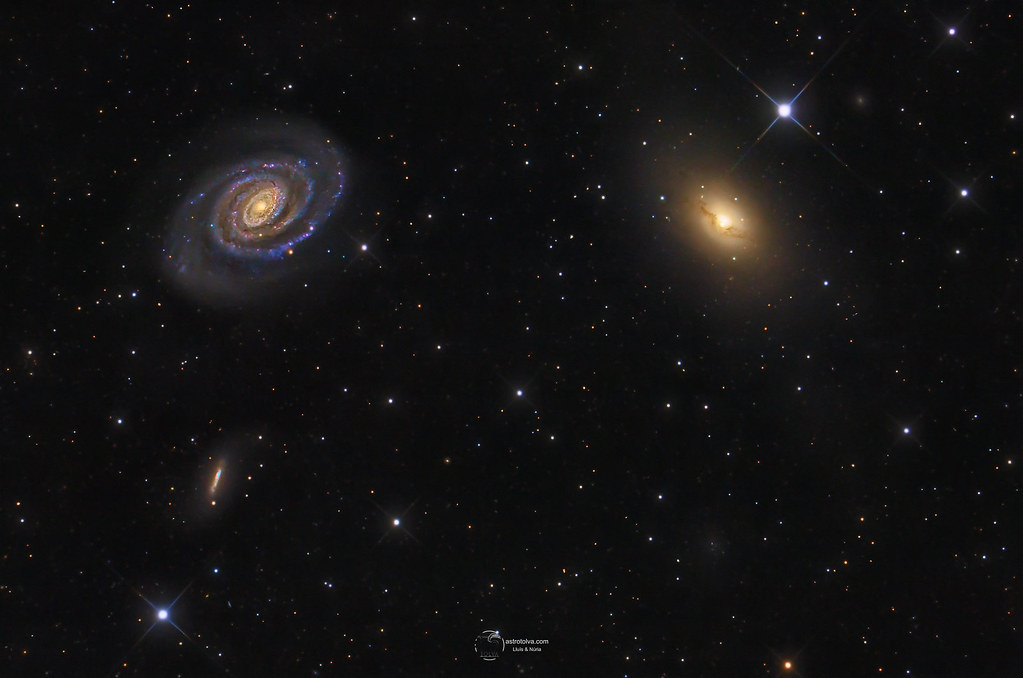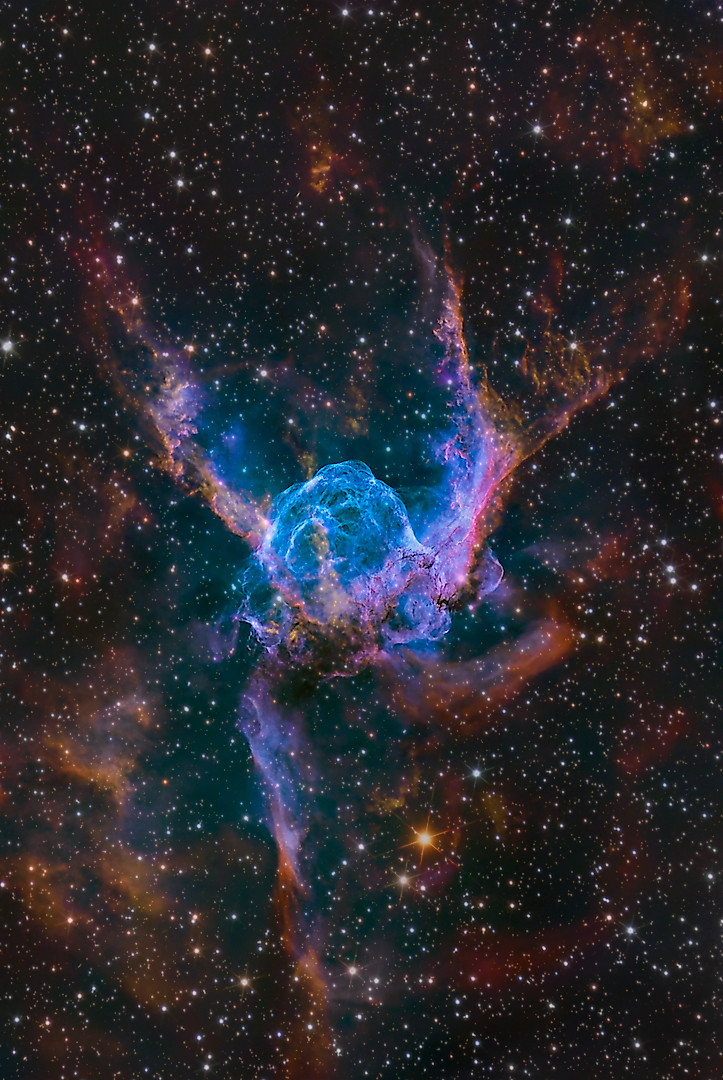Submissions: 2023 May
Re: Submissions: 2023 May
NGC 2467 - Skull and Crossbones Nebula
Known as the "Skull and Crossbones Nebula", NGC 2467 is an extremely active stellar nursery that glows in deep reddish tones and is located within the constellation Puppis. Numerous stars and clusters come together to make this stunning stellar portrait. Among numerous gems in the region, dust lanes and dark globules mark sites of future star formation. One of the most notable clusters within NGC 2467, known as Haffner 18, houses around 50 stars. The NGC 2467 complex lies about 17,000 light-years away.
Photographed in narrowband emission (H-alpha & O-3) at El Sauce Observatory, Rio Hurtado, Chile, during May 2023.
Clear skies,
A.
Copyright: @ae_astrophotons
Scope: Planewave CDK 24”
Filters: H-alpha & O-3
Country: El Sauce Observatory, Rio Hurtado, Chile (T-live)
Date: May 2023
-
KuriousGeorge
- Science Officer
- Posts: 218
- Joined: Wed Dec 30, 2015 7:07 am
- Location: San Diego, CA
- Contact:
Re: Submissions: 2023 May
The Sombrero Galaxy (Reimagined). KG Observatory, Julian , CA.
I say "reimagined" for three reasons...
1. I wanted to capture what the Sombrero might looks like when approaching from a few million light years. The color would likely be "natural" with a smooth halo with no abrupt edge.
2. The May skies in Julian, CA are very dark (21.5+) and steady between weather changes.
3. This is my first use of the relatively new AI sharpening and denoise tools by Russel Croman. Thank you Kevin Morefield for your AI processing tips!
https://www.astrobin.com/bdv7tx/
I say "reimagined" for three reasons...
1. I wanted to capture what the Sombrero might looks like when approaching from a few million light years. The color would likely be "natural" with a smooth halo with no abrupt edge.
2. The May skies in Julian, CA are very dark (21.5+) and steady between weather changes.
3. This is my first use of the relatively new AI sharpening and denoise tools by Russel Croman. Thank you Kevin Morefield for your AI processing tips!
https://www.astrobin.com/bdv7tx/
- Chris Peterson
- Abominable Snowman
- Posts: 18412
- Joined: Wed Jan 31, 2007 11:13 pm
- Location: Guffey, Colorado, USA
- Contact:
Re: Submissions: 2023 May
Actually, it would look just the same from a few million ly away as it does from here, just larger. Same color (none), same contrast.KuriousGeorge wrote: ↑Sun May 21, 2023 4:37 pm The Sombrero Galaxy (Reimagined). KG Observatory, Julian , CA.
I say "reimagined" for three reasons...
1. I wanted to capture what the Sombrero might looks like when approaching from a few million light years. The color would likely be "natural" with a smooth halo with no abrupt edge.
Chris
*****************************************
Chris L Peterson
Cloudbait Observatory
https://www.cloudbait.com
*****************************************
Chris L Peterson
Cloudbait Observatory
https://www.cloudbait.com
Re: Submissions: 2023 May
Coast Guard Beach, Cape Cod.
Social Media :-
www.instagram.com/mmamtani
www.facebook.com/manish.mamtani
www.manishmamtani.com
Story:
Milky rising behind the Coast Guard beach in Cape Cod, MA. I had to push myself to take the 2 hour drive during the weekday. This is my first attempt using a tracker.
EXIF:
Canon EOS-Ra, astro-version
Sigma 28mm f1.4
Benro Polaris.
Sky:
6 images stacked - F2.2, 180 seconds, 800 iso, 28mm
Foreground:
F1.4, 20 seconds, ISO 6400.
Social Media :-
www.instagram.com/mmamtani
www.facebook.com/manish.mamtani
www.manishmamtani.com
Story:
Milky rising behind the Coast Guard beach in Cape Cod, MA. I had to push myself to take the 2 hour drive during the weekday. This is my first attempt using a tracker.
EXIF:
Canon EOS-Ra, astro-version
Sigma 28mm f1.4
Benro Polaris.
Sky:
6 images stacked - F2.2, 180 seconds, 800 iso, 28mm
Foreground:
F1.4, 20 seconds, ISO 6400.
Re: Submissions: 2023 May
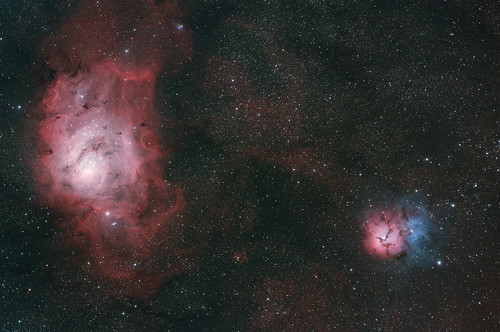 Lagoon (M8) and Trifid (M20) Nebulae by Harley Grady, on Flickr
Lagoon (M8) and Trifid (M20) Nebulae by Harley Grady, on FlickrM8 Lagoon and M20 Trifid Nebula's.
The Lagoon (M8) and Trifid Nebula (M20) are located in the Sagittarius region of the Milky Way. The Lagoon Nebula is also one of only two nebula that are visible with the Naked Eye. Both are emission nebula and are literal star factories, with their superheated gasses creating a beautiful glow. The Lagoon Nebula (left) is located approximately 5,200 light years away and the Trifid Nebula is about 9,000 light years away. Also pictured just above the Trifid nebula is M21 (NGC6531) or “Webs Cross”.
Shot on a ZWO ASI 2600MC Pro
51X300s exposures for
4.1 total hours of integration time
TS Optics 90mm APO Telescope.
Skywatcher EQ6R mount.
Bortle 5 west of the DFW area.
-
Astrodude13
- Ensign
- Posts: 41
- Joined: Sun Jan 19, 2014 11:44 pm
Re: Submissions: 2023 May
 Vela Nebula Detail by Blake Estes, on Flickr
Vela Nebula Detail by Blake Estes, on FlickrTechnical details are as follows:
Paramount ME
Celestron C14 Edge HD
Starizona Hyperstar 14 V4
Optolong L-Pro Luminance filter
ZWO ASI 6200MC Color Camera
124x180sec exposures
Processed in APP and Lightroom
Aurora HDR
-
ExplorerEGYWO
- Ensign
- Posts: 25
- Joined: Mon Jul 19, 2021 6:40 pm
Re: Submissions: 2023 May
 The Egyptian Analemma by Wael Omar, on Flickr
The Egyptian Analemma by Wael Omar, on FlickrWhat a journey!
The Lunar Analemma.
This is the first time that this phenomenon is imaged in EGYPT. The sequence of images was taken from 22 April to 17 May,2023. The idea of the image is that the moon return to its same position in the sky about 50 minutes and 29 seconds later each day so I took an image for the moon 50 minutes and 29 seconds later on successive days over almost a lunar month from the same place every day. Due to the tilted elliptical orbit of the moon this will result in a figure of "8" or infinity sign.
The journey of this image was really challenging and exhausting, on top of that the sleepless nights I went through to stay awake waiting for the scheduled time to take the image of the moon. There were also some cloudy nights and i was a little lucky to see the moon through it when the time of the shoot came. I used Canon 200 D camera with 18 mm lens to shoot the images from the same location and i could see the moon in the images easily but On the last week, the time of the images were on day time , that's why you will see the moon images on these days a little blue ,also they were so faint but i could see them when i zoom deeply on the images but of course the details were absent so I come up with an idea to use my GOTO mount to point to the location of the moon as of course it would be impossible to see it by naked eye then I took an image of it with the help of my Redcat 51 scope then I put it on the same location of the moon on the 18 mm lens image.
Equipment used:
Camera: Canon 200 D.
Lens: canon 18-55 lens - Redcat 51.
Settings:
To know location of the moon each day, all images were taken from same fixed place by 18 mm lens @ F5.7 ,different exposure time and iso values according to moon phase.
For details of the moon, images were taken @55mm and for images that were taken during day time, I use the Redcat 51 @ 250 mm with the GOTO mount.
Foreground image: ISO 100, 30 seconds, F 11.
I make some rotation for the whole Analemma to suit the foreground.
I have gone through this beautiful, Painful and one lifetime experience with a great hope to win APOD nomination, I did everything I could and spare nothing to make this image successful , took a vacation from work on the last 2 weeks to be ready for the moon images as they were after midnight and during day time. I climb up a 50 meters high Minaret to have a clear view of the pyramids and blend this view with the total analemma I imaged.
Location: Great Cairo, EGYPT.
Credit: Wael Omar WO /https://www.instagram.com/waelomar_astrophotography/
Re: Submissions: 2023 May
M51 Whirlpool Galaxy
Imaged from the UK over 2 nights, 19th & 20th May 2023
Altair EDT-F 130mm @ 910mm f7
ASI2600MC Pro no filter
EQ6R Pro
215 x 120s lights - 7h 10mins
40 x Darks, no flats/dark flats
Processed in PI
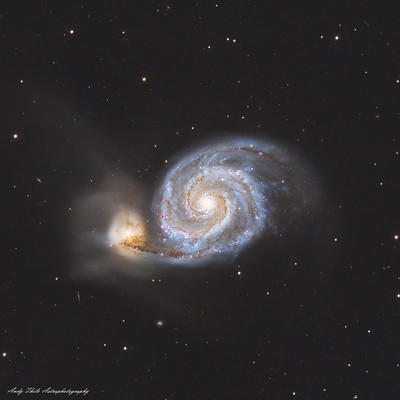 M51_7hrs_210523_closeup by Andy Thilo, on Flickr
M51_7hrs_210523_closeup by Andy Thilo, on Flickr
Imaged from the UK over 2 nights, 19th & 20th May 2023
Altair EDT-F 130mm @ 910mm f7
ASI2600MC Pro no filter
EQ6R Pro
215 x 120s lights - 7h 10mins
40 x Darks, no flats/dark flats
Processed in PI
 M51_7hrs_210523_closeup by Andy Thilo, on Flickr
M51_7hrs_210523_closeup by Andy Thilo, on Flickr-
mathewbrowne
- Ensign
- Posts: 27
- Joined: Mon Jan 16, 2017 11:17 pm
- Contact:
Re: Submissions: 2023 May
A highly rare appearance of the northern lights this far south! Another late night at my favourite local photo spot and finally the northern lights made a brief appearance too. I couldn't see much with the naked eye, but on the back of the camera, gentle pink rays began to form, just strong enough to beat the low cloud and light pollution beyond.
Settings: 14mm, f1.8, ISO 3200, 10 seconds
Nikon Z7II, Sigma 14mm f1.8 art lens
I was capturing a 15 minute timelapse and when I looked at the back of the camera I noticed a distinctive pink glow. Simultaneously, the Glendale aurora app notified me of an ongoing geomagnetic storm. So I shot 10 second frames for 20 minutes and hoped for the best. To my delight, I caught it on camera.
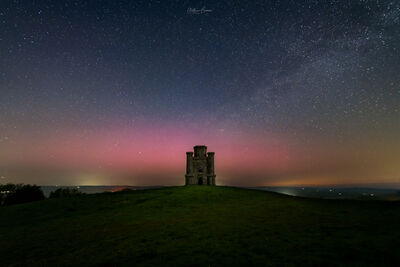 Northern Lights at Paxton's Tower, south Wales, United Kingdom © Mathew Browne via PhotoHound
Northern Lights at Paxton's Tower, south Wales, United Kingdom © Mathew Browne via PhotoHound
Settings: 14mm, f1.8, ISO 3200, 10 seconds
Nikon Z7II, Sigma 14mm f1.8 art lens
I was capturing a 15 minute timelapse and when I looked at the back of the camera I noticed a distinctive pink glow. Simultaneously, the Glendale aurora app notified me of an ongoing geomagnetic storm. So I shot 10 second frames for 20 minutes and hoped for the best. To my delight, I caught it on camera.
 Northern Lights at Paxton's Tower, south Wales, United Kingdom © Mathew Browne via PhotoHound
Northern Lights at Paxton's Tower, south Wales, United Kingdom © Mathew Browne via PhotoHound-
barretosmed
- Science Officer
- Posts: 463
- Joined: Thu Oct 12, 2017 6:04 pm
Re: Submissions: 2023 May
THE MILKY WAY
BEST DETAILS
https://www.astrobin.com/full/yxq0u0/0/
EQUIPMENT:
Canon 6D
Canon lens 24mm 1.4
smarteq pro
1 x 26"
iso 3200 f2.0
LOCATION: San Pedro de Atacama - Chile
DATE 04/16/2023
PROCESSING AND CAPTURE:
Adobe Lightroom Classic Adobe Photoshop Han K. Astrometric STAcking Program (ASTAP) Main Sequence Software Sequence Generator Pro (SGP) Open PHD Guiding Project PHD2 Pavel Mráz SkytechX Pleiades Astrophoto PixInsight
Author: Fernando Oliveira de Menezes
Email: Barretosmed@hotmail.com
(Organizing author of the book Amateur Astrophotography in Brazil)
https://clubedeautores.com.br/livro/ast ... -no-brasil
BEST DETAILS
https://www.astrobin.com/full/yxq0u0/0/
EQUIPMENT:
Canon 6D
Canon lens 24mm 1.4
smarteq pro
1 x 26"
iso 3200 f2.0
LOCATION: San Pedro de Atacama - Chile
DATE 04/16/2023
PROCESSING AND CAPTURE:
Adobe Lightroom Classic Adobe Photoshop Han K. Astrometric STAcking Program (ASTAP) Main Sequence Software Sequence Generator Pro (SGP) Open PHD Guiding Project PHD2 Pavel Mráz SkytechX Pleiades Astrophoto PixInsight
Author: Fernando Oliveira de Menezes
Email: Barretosmed@hotmail.com
(Organizing author of the book Amateur Astrophotography in Brazil)
https://clubedeautores.com.br/livro/ast ... -no-brasil
-
chassaigne
- Ensign
- Posts: 20
- Joined: Sun Mar 19, 2023 3:22 pm
Re: Submissions: 2023 May
Sh2-265, you can find at lower right hand side, is a very dimmed reddish H-alpha diffused nebula spread around 2 degrees northwest of Bellatrix. The nebula is one of gaseous matters forming the Orion Association, has a span of about 50 arc minutes. We can hardly recognize its detailed structures, contains complicated dark nebulae, looks like a ring structure.
Full image and data
https://www.georges-chassaigne.fr/433170348/sh2-265
Full image
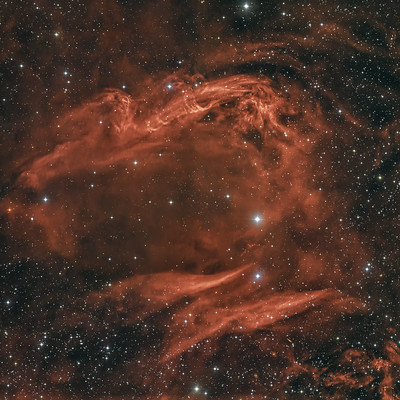 Sh2-265 Hargb 8h20mn by georges chassaigne, sur Flickr
Sh2-265 Hargb 8h20mn by georges chassaigne, sur Flickr
Full image and data
https://www.georges-chassaigne.fr/433170348/sh2-265
Full image
 Sh2-265 Hargb 8h20mn by georges chassaigne, sur Flickr
Sh2-265 Hargb 8h20mn by georges chassaigne, sur Flickr-
chassaigne
- Ensign
- Posts: 20
- Joined: Sun Mar 19, 2023 3:22 pm
Re: Submissions: 2023 May
Sh2-73is located in the constellation Hercules and was mistakenly included in the Sharpless catalog as an emission nebula.We now know that the nebula is simply a molecular cloud. With its relatively high galactic latitude, about 45°, the integrated light of the galaxy illuminates the nebula.
Full image and data
https://www.georges-chassaigne.fr/433170348/sh2-73
Full image
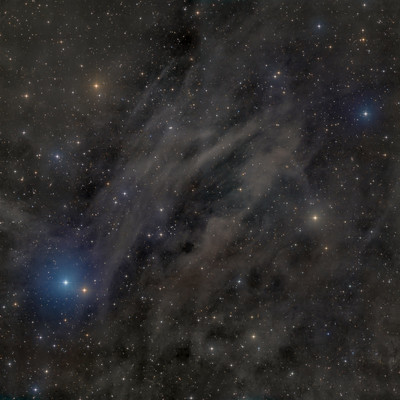 Sh2-73 RGB 28h15mn by georges chassaigne, sur Flickr
Sh2-73 RGB 28h15mn by georges chassaigne, sur Flickr
Full image and data
https://www.georges-chassaigne.fr/433170348/sh2-73
Full image
 Sh2-73 RGB 28h15mn by georges chassaigne, sur Flickr
Sh2-73 RGB 28h15mn by georges chassaigne, sur FlickrRe: Submissions: 2023 May
M 63
Hola a todos mi nombre es Jose Maria Perez, osdejo esta foto por si la veis interesante
estos son los datos
TOMAS:
R: 14 Light de 900 segundos, 14 Darks, 31 Flats y 40 Bias
G: 25 Light de 600 segundos, 25 Darks, 31 Flats y 40 Bias
B: 36 Light de 600 segundos, 36 Darks, 30 Flats y 40 Bias
L: 20 Light de 900 segundos, 20 Darks, 30 Flats y 40 Bias
TEMPERATURA: -10 GRADOS
TUBO: FSQ 106 ED
CCD: SBIG ST-8300M
MONTURA: CGEM
CCD guiar: QHY5II
LUGAR: LAS INVIERNAS (GUADALAJARA)
Un saludo
jose
http://astronomiargb.webcindario.com/M6 ... nombre.jpg
estos son los datos
TOMAS:
R: 14 Light de 900 segundos, 14 Darks, 31 Flats y 40 Bias
G: 25 Light de 600 segundos, 25 Darks, 31 Flats y 40 Bias
B: 36 Light de 600 segundos, 36 Darks, 30 Flats y 40 Bias
L: 20 Light de 900 segundos, 20 Darks, 30 Flats y 40 Bias
TEMPERATURA: -10 GRADOS
TUBO: FSQ 106 ED
CCD: SBIG ST-8300M
MONTURA: CGEM
CCD guiar: QHY5II
LUGAR: LAS INVIERNAS (GUADALAJARA)
Un saludo
jose
http://astronomiargb.webcindario.com/M6 ... nombre.jpg
Last edited by bystander on Thu May 25, 2023 3:34 am, edited 1 time in total.
Reason: Please, no hot links to images > 500 kb. Uploaded image as an attachment.
Reason: Please, no hot links to images > 500 kb. Uploaded image as an attachment.
Re: Submissions: 2023 May
The Sun setting behind Pilot Peak, 5-19-23 © Mack H. Frost
On Friday, May 19, 2023, I traveled to the top of the badlands mountains east of Cody, Wyoming, called the McCullough Peaks. There's an antennae farm on the highest peak and a good BLM road to access the site. From that site, one can see quite a ways in every direction, especially to the northwest. The site is just high enough to zero in on Pilot and Index Peaks in the North Absaroka Mountains east of Yellowstone National Park and Cooke City, Montana. Line of sight is 57-miles/92-km from mountain to mountain and I have no idea how many more miles of astmosphere the Sun had to shine through. Pilot Peak is a glacially carved tooth of volcanic rock that looks like a miniature Matterhorn. Using the Photo Pills app, I positioned my observing site and waited for the event.
I had a tripod mounted Canon 90D camera with an EF 100-400mm f/5.6 lens and a Canon 1.4X extender atteched. With the magnification factor of the camera's sensor added in, that gave me the equivalent of an 896mm lens. 1/400 sec @ f/10, ISO 400. Smoke from the huge forest fires in Alberta, Canada, had drifted into Wyoming and provided a natural filter for the sun's intense light, but increasing the fuzziness of the disk of the Sun. Right at 8:34 PM MDT, as calculated, the Sun started to be eclipsed by Pilot Peak. As it set lower towards the horizon, several large sunspots became more visible. I took many photos of the sunset and this one turned out to be one of the best. I have more images of this event in an album on my Facebook page: https://www.facebook.com/media/set/?set ... 116&type=3 Thanks for looking.
On Friday, May 19, 2023, I traveled to the top of the badlands mountains east of Cody, Wyoming, called the McCullough Peaks. There's an antennae farm on the highest peak and a good BLM road to access the site. From that site, one can see quite a ways in every direction, especially to the northwest. The site is just high enough to zero in on Pilot and Index Peaks in the North Absaroka Mountains east of Yellowstone National Park and Cooke City, Montana. Line of sight is 57-miles/92-km from mountain to mountain and I have no idea how many more miles of astmosphere the Sun had to shine through. Pilot Peak is a glacially carved tooth of volcanic rock that looks like a miniature Matterhorn. Using the Photo Pills app, I positioned my observing site and waited for the event.
I had a tripod mounted Canon 90D camera with an EF 100-400mm f/5.6 lens and a Canon 1.4X extender atteched. With the magnification factor of the camera's sensor added in, that gave me the equivalent of an 896mm lens. 1/400 sec @ f/10, ISO 400. Smoke from the huge forest fires in Alberta, Canada, had drifted into Wyoming and provided a natural filter for the sun's intense light, but increasing the fuzziness of the disk of the Sun. Right at 8:34 PM MDT, as calculated, the Sun started to be eclipsed by Pilot Peak. As it set lower towards the horizon, several large sunspots became more visible. I took many photos of the sunset and this one turned out to be one of the best. I have more images of this event in an album on my Facebook page: https://www.facebook.com/media/set/?set ... 116&type=3 Thanks for looking.
-
PatrickWinkler
- Ensign
- Posts: 82
- Joined: Wed May 25, 2016 4:24 pm
- Location: Traiskirchen (Austria)
- Contact:
Re: Submissions: 2023 May
 Chenonceau and the Milky Way by Joel Klinger, sur Flickr
Chenonceau and the Milky Way by Joel Klinger, sur FlickrHere is an unseen (up to now) picture of the castle of Chenonceau (France): the Marques Tower and the Gallery with the Milky Way above, reflecting in the fountain of Catherine of Medicis with a perfectly still water. What a pleasure to witness such a rare magical moment!
Indeed a combination of multiple factors is needed to achieve this picture:
- a clear sky,
- being between April and June,
- no Moon and no wind,
- no vegetation in the basin,
- and the lights of the castle shut.
To be sure not to miss that moment, I have been waiting for it for a while - more than one year actually.
On that panorama of 39 pictures, the Milky Way shows its beautiful internal structures with dense starry areas sometimes hidden by huge dust clouds. Some pink nebulae can also be found (in the galactic heart, above the forest, yet also in the top left corner of the picture). A surprise too: a light airglow appears here and there, especially at the left of the Marques tower and above the forest on the right of the picture (it is here visible as red-pink colored strips).
Date: 19th May 2023
Location: Chenonceaux, France
Nikon D610 Astrodon + Sigma 35mm Art
Panorama of 3 rows of 13 pictures
- Sky: 1 row of 13 pictures, each one being a stack of 5 shots at 8s, f/2, ISO3200
- Castle: 1 row of 13 pictures at 20s, f/2, ISO3200
- Fountain: 1 row of 13 pictures at 30s, f/2, ISO3200
No composite | No AI
-
barretosmed
- Science Officer
- Posts: 463
- Joined: Thu Oct 12, 2017 6:04 pm
Re: Submissions: 2023 May
Markarian's Chain of Galaxies
BEST DETAILS
https://www.astrobin.com/full/yqf1m9/B/
EQUIPMENT:
Esprit 150mm triplet
zwo asi 6200mc
Mount CEM120
Frames 196X300"
LOCATION: Munhoz - MG - Brazil
DATES: From 03/23/2023 to 05/21/2023
PROCESSING AND CAPTURE:
Adobe Photoshop, ASTAP, SGP, PHD2 and PixInsight
Author: Fernando Oliveira de Menezes
Email: Barretosmed@hotmail.com
(Organizing author of the book Amateur Astrophotography in Brazil)
https://clubedeautores.com.br/livro/ast ... -no-brasil
BEST DETAILS
https://www.astrobin.com/full/yqf1m9/B/
EQUIPMENT:
Esprit 150mm triplet
zwo asi 6200mc
Mount CEM120
Frames 196X300"
LOCATION: Munhoz - MG - Brazil
DATES: From 03/23/2023 to 05/21/2023
PROCESSING AND CAPTURE:
Adobe Photoshop, ASTAP, SGP, PHD2 and PixInsight
Author: Fernando Oliveira de Menezes
Email: Barretosmed@hotmail.com
(Organizing author of the book Amateur Astrophotography in Brazil)
https://clubedeautores.com.br/livro/ast ... -no-brasil
-
maxifalieres
- Ensign
- Posts: 18
- Joined: Fri Dec 18, 2020 6:39 pm
Re: Submissions: 2023 May
Hi! I'm sharing this picture of the Crescent Moon taken today 26-05-23 in my backyard with my telescope 200 f4.

Luna Cresciente
by Maximiliano Falieres, en Flickr
I hope that you like it an consider it an APOD
Greetings!

Luna Cresciente
by Maximiliano Falieres, en Flickr
I hope that you like it an consider it an APOD
Greetings!
-
cosmicwreckingball
- Ensign
- Posts: 31
- Joined: Tue May 26, 2015 2:57 pm
- AKA: Matt Harbison
- Location: Chattanooga, TN
- Contact:
Re: Submissions: 2023 May
Sol 2023-5-25
Giant resolution images of our Star! Zoomable and comparable at different layers of wavelength on the Sun. Click the link below to see the detail and resolution (around 12K). Captured by myself from Chattanooga TN and then coded onto my website for a true unique look at the different layers of our Star. The more detail I manage to reveal, the more ORGANIC our star looks to me!
Visible in the selectable, zoomable, and interactive images are:
1- The Photosphere at 540nam (green) - processed in green because that is the color visible through a telescope at that wavelength. Captured by my 100mm SkyWatcher Evostar and an Altair Hershel Wedge.
2- The lower level of the Chromosphere at 390nmm, visible in the Calcium K spectrum (purple). Captured with my 80mm Lunt CaK 1800 blocking filter on a Lunt Engineering telescope.
3- The upper level of the Chromsophere at 640nm (orange x 2) and it's inversion to reveal the movement of the filaments of hot plasma. Captured through my Lunt 80mm Hydrogen Double Stack telescope.
https://www.spaceforeverybody.com/SolarContinuum/

Giant resolution images of our Star! Zoomable and comparable at different layers of wavelength on the Sun. Click the link below to see the detail and resolution (around 12K). Captured by myself from Chattanooga TN and then coded onto my website for a true unique look at the different layers of our Star. The more detail I manage to reveal, the more ORGANIC our star looks to me!
Visible in the selectable, zoomable, and interactive images are:
1- The Photosphere at 540nam (green) - processed in green because that is the color visible through a telescope at that wavelength. Captured by my 100mm SkyWatcher Evostar and an Altair Hershel Wedge.
2- The lower level of the Chromosphere at 390nmm, visible in the Calcium K spectrum (purple). Captured with my 80mm Lunt CaK 1800 blocking filter on a Lunt Engineering telescope.
3- The upper level of the Chromsophere at 640nm (orange x 2) and it's inversion to reveal the movement of the filaments of hot plasma. Captured through my Lunt 80mm Hydrogen Double Stack telescope.
https://www.spaceforeverybody.com/SolarContinuum/

Matt Harbison
President Emeritus, Barnard Astronomical Society of Chattanooga
Cameras, Binoculars, Dobs, Cats, and Refractors. Whatever it takes!
President Emeritus, Barnard Astronomical Society of Chattanooga
Cameras, Binoculars, Dobs, Cats, and Refractors. Whatever it takes!
Re: Submissions: 2023 May
THE FIGHTING DRAGONS OF ARA
- NGC6188, Edge Nebula
- Deep sky 762mm LRGBHOO
- Constellation Ara the Altar

Last week I already show you the fighting dragons of Ara, back then I edited an acquired image set at 1500mm focal length. Today I show this wonderful nebula again, but this time with pictures I took via remote telescope in Australia. With a focal length of 762mm you can now see the dragons in all their glory Developed as a LRGBHSO version in blue/orange - I hope you like it! Happy Pentecost weekend to you all!
Developed as a LRGBHSO version in blue/orange - I hope you like it! Happy Pentecost weekend to you all!
The colors in NGC 6188 are due to the presence of various chemical elements in the gas, such as hydrogen, oxygen, and sulfur. The energetic radiation from the young stars in this beautiful nebula excites these elements and causes them to glow with different colors. This creates an impressive visual spectacle.
NGC 6188, or the Edge Nebula, is a large H-II region in the constellation of Ara, located in the southern hemisphere. It is a vibrant and colorful assemblage of gas and dust, made to glow by intense radiation from young, hot stars. The H-II region is approximately 4,000 light-years from Earth and spans an area of about 200 light-years. It is part of a larger star-forming region that also includes open star cluster NGC 6193. The energetic radiation from the young stars causes the surrounding gas to become ionized, resulting in the characteristic glowing clouds and filaments. A stunning example of how new stars are formed and how gas and dust interact in the Universe. Exploring NGC 6188 and similar H-II regions is helping to deepen our understanding of star formation and galaxy evolution.
Telescope: Takahashi TOA-130, Reducer, 762mm
Camera: FLI 16803 Camera, Astrodon Gen2 E Series Filter, 3nm
Lights: 8xLuminance per 240s, / 8xRed/8xGreen/8xBlue per 240s, / 8xhAlpha/8xSII/8xOIII per 300s Bin1x1
Location: iTelescope.Net at Siding Spring Observatory Australia
Image editing:
Mainly Pixinsight, Photoshop, Lightroom, GraXpert, BTX Blur Terminator, Noise Terminator, Star X Terminator
#arathealtar #ngc6188 #randnebula #fightingdragonsofara #fightingdragons #universe #artofpixastro #astrophotography #itelescope
- NGC6188, Edge Nebula
- Deep sky 762mm LRGBHOO
- Constellation Ara the Altar

Last week I already show you the fighting dragons of Ara, back then I edited an acquired image set at 1500mm focal length. Today I show this wonderful nebula again, but this time with pictures I took via remote telescope in Australia. With a focal length of 762mm you can now see the dragons in all their glory
The colors in NGC 6188 are due to the presence of various chemical elements in the gas, such as hydrogen, oxygen, and sulfur. The energetic radiation from the young stars in this beautiful nebula excites these elements and causes them to glow with different colors. This creates an impressive visual spectacle.
NGC 6188, or the Edge Nebula, is a large H-II region in the constellation of Ara, located in the southern hemisphere. It is a vibrant and colorful assemblage of gas and dust, made to glow by intense radiation from young, hot stars. The H-II region is approximately 4,000 light-years from Earth and spans an area of about 200 light-years. It is part of a larger star-forming region that also includes open star cluster NGC 6193. The energetic radiation from the young stars causes the surrounding gas to become ionized, resulting in the characteristic glowing clouds and filaments. A stunning example of how new stars are formed and how gas and dust interact in the Universe. Exploring NGC 6188 and similar H-II regions is helping to deepen our understanding of star formation and galaxy evolution.
Telescope: Takahashi TOA-130, Reducer, 762mm
Camera: FLI 16803 Camera, Astrodon Gen2 E Series Filter, 3nm
Lights: 8xLuminance per 240s, / 8xRed/8xGreen/8xBlue per 240s, / 8xhAlpha/8xSII/8xOIII per 300s Bin1x1
Location: iTelescope.Net at Siding Spring Observatory Australia
Image editing:
Mainly Pixinsight, Photoshop, Lightroom, GraXpert, BTX Blur Terminator, Noise Terminator, Star X Terminator
#arathealtar #ngc6188 #randnebula #fightingdragonsofara #fightingdragons #universe #artofpixastro #astrophotography #itelescope
Re: Submissions: 2023 May
NGC4631 The Whale Galaxy
https://www.deepskyobjects.com/Galaxies ... 1_LRGB.asp
Copyright: Behyar Bakhshandeh, Carlsbad, CA
https://www.deepskyobjects.com/Galaxies ... 1_LRGB.asp
Copyright: Behyar Bakhshandeh, Carlsbad, CA
Re: Submissions: 2023 May
Cascade in the Eastern Veil
Click on above for larger image.
Higher resolution & info @ https://www.kinchastro.com/bat-nebula-i ... -veil.html
Click on above for larger image.
Higher resolution & info @ https://www.kinchastro.com/bat-nebula-i ... -veil.html
-
Rafeee
- Ensign
- Posts: 50
- Joined: Fri Feb 24, 2012 8:52 pm
- Location: Hungary, Zselic Starry Sky Park
- Contact:
Re: Submissions: 2023 May
H-alpha sun - Amazing CME
Copyright: Rafael Schmall
https://www.astrobin.com/users/Rafeee/
At the moment, there is no ... space weather phenomenon worth mentioning. I liked the comment on the page dealing with space weather, meanwhile there is the huge CME which is approx. It flew out of the Sun at 5 million km/h... It could probably have been a more peaceful kind of ejection, but it was still a Solar disturbance.
I think the whole thing was very pleasant with the usual inverted solar disk. I have never seen such an eruptive protuberance, even though I often observe the Sun.
Image Details:
Equipment: ZWO ASI290MM, Lunt LS-100ha, Lunt B1800, Fornax 150
Exif data: exp: 1,0ms, gain:50, 30sec 10%
Processing: Adobe Photoshop, PIPP, FireCapture
Location: Hungary, Zselic Starry Sky Park, Zselic Park of Stars
Copyright: Rafael Schmall
https://www.astrobin.com/users/Rafeee/
At the moment, there is no ... space weather phenomenon worth mentioning. I liked the comment on the page dealing with space weather, meanwhile there is the huge CME which is approx. It flew out of the Sun at 5 million km/h... It could probably have been a more peaceful kind of ejection, but it was still a Solar disturbance.
I think the whole thing was very pleasant with the usual inverted solar disk. I have never seen such an eruptive protuberance, even though I often observe the Sun.
Image Details:
Equipment: ZWO ASI290MM, Lunt LS-100ha, Lunt B1800, Fornax 150
Exif data: exp: 1,0ms, gain:50, 30sec 10%
Processing: Adobe Photoshop, PIPP, FireCapture
Location: Hungary, Zselic Starry Sky Park, Zselic Park of Stars
-
astrosirius
- Science Officer
- Posts: 111
- Joined: Fri Nov 23, 2012 11:17 am
- Location: Barcelona Spain
- Contact:
Re: Submissions: 2023 May
Trio Galaxies in Virgo Constellation NGC 5363 and NGC 5364 and NGC 5360
NGC 5363 is the elliptical galaxy in the upper-left corner of the image. And NGC 5364 is the spiral galaxy in the lower right. These two galaxies are likely in the early stages of gravitational interaction.
NGC 5360 The small one is a Lenticular Galaxy classified as (S0-Aa) according to the Hubble and de Vaucouleurs galaxy morphological classification.
Telescope: RC16"
Mount: ASA DDM85XL
Reducer: Massimo Riccardi Reducer 0.75x
CMOS: QHY268C (resolution 0.32"/px)
Total exposure: 20h (241x300sec)
https://live.staticflickr.com/65535/529 ... e043_o.jpg
NGC 5363 is the elliptical galaxy in the upper-left corner of the image. And NGC 5364 is the spiral galaxy in the lower right. These two galaxies are likely in the early stages of gravitational interaction.
NGC 5360 The small one is a Lenticular Galaxy classified as (S0-Aa) according to the Hubble and de Vaucouleurs galaxy morphological classification.
Telescope: RC16"
Mount: ASA DDM85XL
Reducer: Massimo Riccardi Reducer 0.75x
CMOS: QHY268C (resolution 0.32"/px)
Total exposure: 20h (241x300sec)
https://live.staticflickr.com/65535/529 ... e043_o.jpg
Last edited by bystander on Mon May 29, 2023 12:29 am, edited 1 time in total.
Reason: Please, no hot links to images > 500 kb. Substituted smaller image.
Reason: Please, no hot links to images > 500 kb. Substituted smaller image.
Lluís Romero Ventura
http://astrotolva.com/
http://astrotolva.com/
-
jarkoh8888
- Asternaut
- Posts: 2
- Joined: Mon May 29, 2023 5:14 am
Re: Submissions: 2023 May
The Winged Helm of Thor - NGC2359
NGC 2359, commonly known as Thor's Helmet, is an emission nebula located in the constellation Canis Major, approximately 15,000 light-years away from Earth. It measures about 30 light years across.
It earned its nickname "Thor's Helmet" due to its resemblance to the legendary headgear worn by the Norse god Thor.
Thor's Helmet is an example of a superbubble, which is a large cavity formed by the combined stellar winds of massive stars and the shockwaves from supernova explosions. The central star responsible for shaping the nebula is a Wolf-Rayet star, a highly evolved, massive, and extremely hot star nearing the end of its life.
The nebula itself is composed of glowing gas and dust, with a distinct bubble-like structure surrounding the central star. The intense stellar winds from the Wolf-Rayet star have created shockwaves that compress the surrounding interstellar material, causing it to glow brightly.
The colors seen in the nebula are the result of different elements present in the gas. Broadband and narrowband data was used to compose this image. Red hues come from ionized hydrogen gas (HII regions), while blue and violet tones come from doubly ionized oxygen (OIII regions). The yellow hues come from ionised sulphur gas (SII regions).
This was taken from my observatory in the River Murray International Dark Sky Reserve in South Australia in January and February 2023. About 45 hours of imaging time was required for this image.
Link to uncompressed image: https://storage.googleapis.com/dso-brow ... 2x3050.jpg
Acquisition Data:
Imaging Site: Swan Reach Imaging Services
Mount: Paramount ME
Lens: Takahashi Mewlon 250 CR, 2500mm@ F10
Camera: ZWO ASI 2600
LRGB: 300:65:65:65 min
HOS: 740:410:910 min
total Integration 45:55 hours
Temp:-10 degrees
Gain: 100
Offset: 50
NGC 2359, commonly known as Thor's Helmet, is an emission nebula located in the constellation Canis Major, approximately 15,000 light-years away from Earth. It measures about 30 light years across.
It earned its nickname "Thor's Helmet" due to its resemblance to the legendary headgear worn by the Norse god Thor.
Thor's Helmet is an example of a superbubble, which is a large cavity formed by the combined stellar winds of massive stars and the shockwaves from supernova explosions. The central star responsible for shaping the nebula is a Wolf-Rayet star, a highly evolved, massive, and extremely hot star nearing the end of its life.
The nebula itself is composed of glowing gas and dust, with a distinct bubble-like structure surrounding the central star. The intense stellar winds from the Wolf-Rayet star have created shockwaves that compress the surrounding interstellar material, causing it to glow brightly.
The colors seen in the nebula are the result of different elements present in the gas. Broadband and narrowband data was used to compose this image. Red hues come from ionized hydrogen gas (HII regions), while blue and violet tones come from doubly ionized oxygen (OIII regions). The yellow hues come from ionised sulphur gas (SII regions).
This was taken from my observatory in the River Murray International Dark Sky Reserve in South Australia in January and February 2023. About 45 hours of imaging time was required for this image.
Link to uncompressed image: https://storage.googleapis.com/dso-brow ... 2x3050.jpg
Acquisition Data:
Imaging Site: Swan Reach Imaging Services
Mount: Paramount ME
Lens: Takahashi Mewlon 250 CR, 2500mm@ F10
Camera: ZWO ASI 2600
LRGB: 300:65:65:65 min
HOS: 740:410:910 min
total Integration 45:55 hours
Temp:-10 degrees
Gain: 100
Offset: 50


